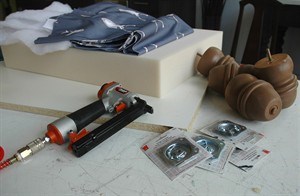
Tools and materials used in reupholstering furniture are shown in a handout photo. THE CANADIAN PRESS/HO-Andrea Ford, Re: Style Studio
January 30, 2014 - 6:00 AM
VICTORIA - Homeowners who take a do-it-yourself approach to home decor projects should proceed cautiously with reupholstery. Instead of stripping down a couch, experts recommend starting small and simple and progressing to advanced pieces.
Andrea Ford, owner of Re: Style Studio in Toronto, says progression is important to achieve success in bigger, more complicated projects down the road.
"I would start with something like a dining room chair," says Ford. "It's a very basic concept, but one of the things you have to learn with upholstery is how to manipulate the fabric, so a simple chair is an easy place to start."
Ford teaches upholstery workshops through her studio, in addition to weekend classes at Lee Valley Tools locations in the Toronto area. In all sessions she teaches, Ford offers hands-on experience with theory.
While she is able to help homeowners with their individual projects in her studio workshops, she often discourages them from taking on advanced pieces.
"In terms of progression, never start with a wingback chair," she says. "They are difficult not just in terms of fabric pulling and manipulating perspective, but it's a jigsaw puzzle. If you staple things in the wrong order when you're recovering it you may never get it back together.
"You need to have some of that knowledge, and there are a lot of industry techniques that can be hard to learn how to do on your own."
Before taking on reupholstery, Ford recommends investing in the proper tools. She experienced firsthand the impact using inefficient tools can have on a beginner's hands.
"The first project I did, I didn't have the proper staple lifters and spring-loaded pliers," says Ford. "I tore my hands apart, and then because the piece was dusty and old, the cuts I had from the improper tools got infected."
The tools Ford recommends for reupholstery include: a staple lifter, small, bent nose, spring-loaded pliers and a pair of work gloves that protect fingertips, palms and knuckles while being pliable.
Staplers are also important tools for reupholstery. While many homeowners may have a hand-stapler, Ford and Cam Russell, instructor at Camosun College's fine furniture joinery program in Victoria, recommend using either an electric or pneumatic stapler.
"You really need either an electric stapler or an air-powered stapler to make it work and get the staples set deep enough," he says.
Making sure the upholstery fabric is taut and manipulated properly is an integral part of reupholstery. Russell says the use of spray adhesive can help secure the foam and bonded polyester batting before covering it with fabric.
"If you wrap your foam in an old unprinted cotton, you're doing the pull with that fabric and when you put your good upholstery fabric on all the hard work is done for you," explains Russell.
"You just have to get a tight pull to get the pattern right, but you don't have to do all the shaping."
A common mistake when taking on a reupholstery project is choosing the wrong fabric. While there are great options in various fabrics, some materials that are suited for clothing or drapery wouldn't work for upholstery.
"Upholstery fabric works best because it has got a weave. You can pull it in both directions," says Russell. "People will go to a fabric store and see a fabric that they like, but it isn't for upholstery, it's for dressmaking.
"When you try to pull it, it will pull differently side to side, and front to back, and typically upholstery fabric is woven in a way that you can pull it the same way from either direction."
News from © The Canadian Press, 2014